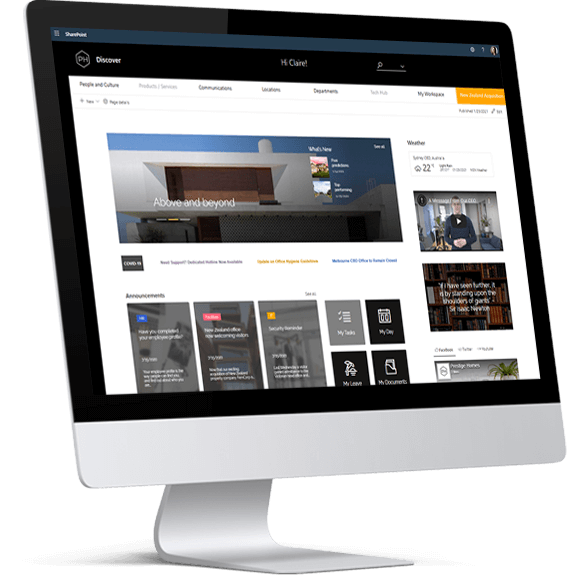Employee intranets have been around since the mid-90s (with a reputation for being a little clunky back in the day). The modern employee intranet is far more functional and centred around a seamless digital employee experience, tailored to the needs of employees and the broader organisation.
“Organisations with high employee engagement outperform those with low levels of engagement by 202%”
Gallup

FREE REPORT
How to Build an Intranet Business Case
What is an Employee Intranet?
An employee intranet can be defined as a private centralised platform enabling employees to receive company updates, access and share important documents, communicate, collaborate, and engage with each other and the organisation.
An employee intranet can be built from scratch or leverage an existing base technology such as SharePoint. Intranets in a box are becoming increasingly more popular, giving organisations the flexibility to select pre-built modules, reducing costs and time to implement. Traditionally, it could take upwards of 12 months to create an intranet. However, a SharePoint intranet in a box like Injio, can be configured, built and launched in a matter of weeks.

Features of Employee Intranets:
News and announcements
Executive Support
Staff directory
Image & video gallery
Employee recognition
Events calendar
Powerful search
Policy attestation
Ideation engine
Interactive office maps
Benefits of Injio Employee Intranet
According to Gallup, 85% of employees are not engaged in the workplace. This is an alarming statistic when considering the impact that disengaged employees can have on productivity and performance. An employee intranet should lie at the heart of any organisation’s digital workplace and be the go-to source for company news, announcements, policies, procedures and more.
Improved communication
With a reported 74% of employees feeling like they are missing out on company news, it’s no wonder that 72% of employees do not fully understand their company’s strategy.
Uninformed employees are likely to be less invested in organisational success. The role of an employee intranet should be to create open communication streams for not only the organisation to speak to employees, but for employees to communicate with each other and back to the organisation. According to Gartner, more informed employees outperform their peers by a staggering 77%. Using an employee intranet, organisations can target news and announcements for increased relevance and engagement.

More collaboration
One Salesforce study highlighted that 86% of employees cite lack of collaboration for workplace failures. Workforces are becoming more dispersed, with employees working in the office, from a café or even another country. Technology is a powerful connector enabling us to work together from anywhere, at any time. Collaboration is important because it supports productivity and fosters connection and culture. The Economist reports that 33% of employees say the ability to collaborate makes them more loyal. An employee intranet can support collaboration through a powerful staff directory and team hub spaces.
Better engagement
Engaged employees are likely to be more productive and have greater wellbeing. Research shows that more engaged workplaces result in reduced absenteeism. According to a Gallup study, highly engaged workplaces saw 41% lower absenteeism. This is significant considering the reportedly high number of disengaged employees. An intranet can drive employee engagement by making staff feel recognised and acknowledged. Valuable employee recognition modules and performance appraisal workflows can ensure that good work is being celebrated and that two way communication is supported.

Enhanced productivity
Without the right tools and systems in place, employees can waste countless hours looking for documents and chasing up approval forms. Not only does this cost a business money in time lost, but it’s a frustrating experience for employees which could contribute to staff turnover. To improve productivity, leverage your employee intranet for document management: a centralised repository of important policies, procedures, templates and forms.
What to Look for in an Employee Intranet
Responsiveness
With employees working from any location, it’s essential that your employee intranet is accessible and usable on any device – whether it’s a desktop, mobile or tablet.
Targeted communications
Make sure your employee intranet can target users based on a range of criteria (e.g. department, location and role) to improve relevance and engagement.
Personalisation
Drive user adoption and engagement by giving users the ability to personalise their own intranet experience. This could include the ability for users to bookmark links, systems, people and documents.
Ease of use
Not only does your employee intranet need to deliver a fantastic end user experience, but it also needs to be easy to manage and update by the intranet managers
Design flexibility
Choose an intranet that gives you the flexibility to reflect your organisation’s branding and identity.







